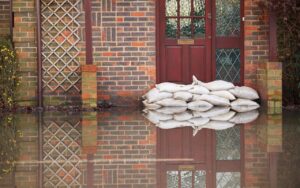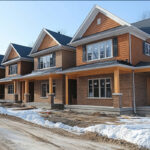
Author: Dane M. Dasent P.E.
(Director of Civil Forensics at SBSA LLC, a Charles Taylor Company)
It’s no secret that water damage is a major threat to any community through storms, flooding, water line breaks, etc. However, water can also cause significant damage to a construction project. In most cases, the geotechnical reports that are prepared before a project begins strongly caution that water on a site must be carefully controlled during construction and after completion of the project. Yet, despite widespread awareness and warnings of the need to prioritize the prevention and/or mitigation of surface water during the planning and building process, the reality is that many companies are still struggling to get their arms around this very slippery problem.
Fortunately, while every project necessitates its own tailored plan, there is a tried-and-true framework that all construction companies can use as a starting point to avoid nightmare scenarios.
BEING PROACTIVE
When a construction site experiences water damage, there are a few key factors in play. If caught early on, a construction company can work with outside experts to verify that the proper site grading was performed and that it has grading certificates prepared by a licensed surveyor stating that the site was graded in conformance with the applicable codes and design criteria. The company should also double check that the civil engineering and grading drawings clearly demonstrate the need to ensure that the ground is sloped away from buildings’ foundations to avoid flood damage. This is especially critical during the construction process when there are generally open excavations next to the buildings that make the newly constructed building elements extremely susceptible to water damage.
If adequate preventative measures such as preventing water near the foundations and open trenches, and a proper construction water-management plan have not been implemented or discussed yet, the expert can provide recommendations to the construction company about how to address these shortcomings.
In the cases where a structure has been already completed, a forensic expert can evaluate whether the building cracked, settled or otherwise sustained damage as a result of water. Ultimately, it’s important to double check every plan and water-management contingency before breaking ground. Even when it comes to liquid matter, it is still better to measure twice and cut once.
BEING REACTIVE
However, sometimes construction companies can do everything by the book and double check their work, and water damage might still occur in a number of ways.
For example, many construction companies find themselves dealing with water issues after the initial clearing of a site of vegetation and topsoil for the new construction. With the changes to the ground surface and existing vegetation removed, contractors can inadvertently cause runoff issues. This most generally can occur because the drainage flow patterns on the site are altered and because the bare ground results in greater quantities of runoff during rainfall events.
Similarly, construction sites can run into surface water issues as a result of impacting the existing underground drainage and water distribution systems while excavating. Rupturing a large high pressure water line on a construction site can cause significant damage to ongoing construction.
There are also documented cases where construction companies may have done everything possible to prevent water issues on their site, but because of the changes in the site imperviousness, grading and ground cover, the surface runoff from the site ends up impacting other neighboring and/or downstream properties, causing damages even when builders believed they had protected themselves from liability. In one case, development of a residential property resulted in negatively impacting a private stream and pond downstream of the site with the killing of fish and loss of use of the waterways.
ALL THINGS CONSIDERED
One of the most important factors for construction companies to consider when planning for the risk of water damage is to carefully work with all the different disciplines that may touch or work on a construction site and ensure they are all aligned with the strategies in place to prevent water-damage issues. Whether this task is assigned to the overall designer who put together the initial plans, the general contractors implementing said plans or the landscaping contractors that may be involved in the later stages of the development, it is important to ensure that every group working on the project remains steadfast in following the same plan and the project is sub-coordinated at every level.
Another practice that is becoming more popular among construction companies is peer review, where outside third-party experts are asked to come in and evaluate a project’s plans and essentially review the designers’ and the construction company’s math and risk plan to make sure there are no inadvertent errors.
Additionally, new technologies like drones are making it easier for firms to confirm the correctness of the initial site grading, evaluate site risks and monitor these aspects of the project in real time as the construction progresses.
Ultimately, it is impossible to fully eliminate the risks or damages to construction projects due to human errors associated with construction project planning and evaluation water damage risk, but by leveraging outside help, double checking the design and drawings through peer review and leveraging new technologies to actively monitor sites, construction companies can get ahead of water risk and protect themselves from physical, legal or financial consequences that these water issues can create.
About Charles Taylor’s Engineering Technical Services:
Charles Taylor Construction Engineering Technical Services (CTETS) is a leading provider of multidisciplinary expertise in design, construction, and property services. With a strong foothold in construction, legal, and insurance, our team of 50+ professionals specialize in forensic engineering, construction management, and property planning and redesign. Together, we offer a comprehensive suite of professional services that cover the entire spectrum of a building’s life cycle, from its conceptualization to rehabilitation.


